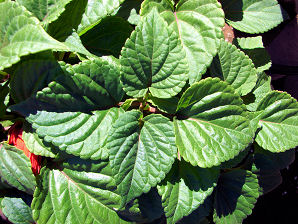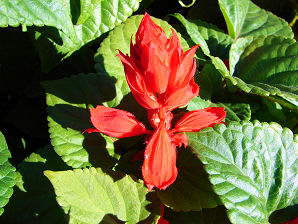Xeriscape Landscaping Plants For The Arizona Desert Environment.
Pictures, Photos, Information, Descriptions,
Images, & Reviews.
Annuals.
Salvia, Salvia splendens.
We Are Proud Of Our SafeSurf Rating!
Click On Any Of The Following Links By Amazon.Com
For Books, & Videos About Wildflowers Of Arizona & The Southwest USA. No Obligation!
 |
| Salvia, Salvia splendens. Also Called: Lady In Red Sage. March 10, 2008. Glendale, Arizona. |
|---|
 |  |
| Lady In Red Salvia. Leaves | Salvia splendens. Flowers |
|---|
Lady In Red Salvia.
We wish to thank Wikipedia, the free encyclopedia for some of the information on this page. We share images and information with Wikipedia. Salvia splendens or Bedding Sage is probably the most commonly grown ornamental of the salvia species. Its normal color is a brilliant scarlet red, but S. splendens also comes in lavender, orange, purple, yellow and white. This annual salvia normally grows from about 8 to 30 inches tall, sometimes taller, with large flower spikes that are above its dark green, heart-shaped leaves. They grow well in full sun, but they also tolerate partial shade. Lady In Red Salvia is a very attractive annual (Sometimes called perannual), wild flower perfect for the hummingbird garden. Salvia splendens prefers sharp-draining soil. Lady In Red Sage is a sub-shrub perennial in warmer climates and an annual where winter temperatures stay below freezing for more than a few hours at a time. Lady In Red Sage reaches 2 ' - 4 ' tall, with 1"-3" heart shaped leaves on long petioles (leaf stems) opposite each other on a square stem. The showy flowers are bright red, about an inch or two long, and arranged in whorls along the upright stem. Lady In Red Sage blooms appear continuously from late winter to first frost. Salvia splendens can tolerate some shade but does best in full sun, it tolerates drought, but flowering may suffer without supplemental watering. Does best in well drained soil but; will grow in hard, compacted, clay soil, which is a common soil in Phoenix. It is a colorful annual popular with hummingbird, bees, and other birds. Perfect plant for the hummingbird garden.
Quick Notes:
Height: 2 to 4 feet tall. 1 to 2 feet spread.
Flowers: Bright red, 2" - 4" flower spikes.
Flowering Time: March to November.
Leaves: Simple, ovate, serrate, reticulate, semi-evergreen, green, opposite/subopposite, 1" - 3" heart shaped leaves on long petioles.
Found: Native to Brazil. The USDA claims it is native of the USA (CT, MA, OH, UT, WI), USA+ (PR).
Hardiness: Said to grow well in Zone 5b. Clinton, Ontario, Canada.
Soil pH requirements:
Sun Exposure:
Elevation: Reported in Brazil, growing at 6,600 to 9,800 feet.
Habitat: Sandy desert soils, hot, sunny areas, good drainage, will grow in hard, compacted, clay soil.
Miscellaneous: Flowering Photos Taken March 10, 2008. Glendale, Arizona. Great xeriscape plant.
|
We Are Proud Of Our SafeSurf Rating!
Click On Any Of The Following Links By Amazon.Com
For Books, & Videos About Wildflowers Of Arizona & The Southwest USA. No Obligation!
| © 1966 - Present, Audrey, Eve, & George DeLange |